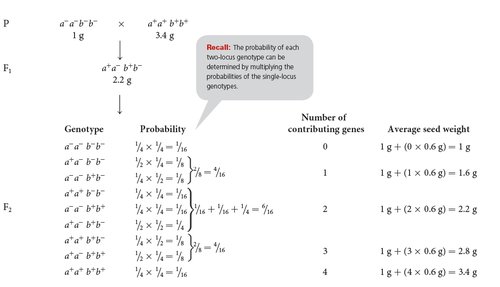WORKED PROBLEMS
WORKED PROBLEMS
Problem 1
Seed weight in a particular plant species is determined by pairs of alleles at two loci (a+a− and b+b−) that are additive and equal in their effects. Plants with genotype a−a− b−b− have seeds that average 1 g in weight, whereas plants with genotype a+a+ b+b+ have seeds that average 3.4 g in weight. A plant with genotype a−a− b−b− is crossed with a plant of genotype a+a+ b+b+.
What is the predicted weight of seeds from the F1 progeny of this cross?
If the F1 plants are intercrossed, what are the expected seed weights and proportions of the F2 plants?
Solution Strategy
What information is required in your answer to the problem?
The predicted weight of seeds from the F1 progeny.
The expected seed weights and their proportions among the F2 progeny.
What information is provided to solve the problem?
Seed weight is determined by pairs of alleles at two loci (a+a− and b+b−).
The alleles are additive and equal in their effects.
Plants with genotype a−a− b−b− have seeds that average 1 g in weight.
Plants with genotype a+a+ b+b+ have seeds that average 3.4 g in weight.
A plant with genotype a−a− b−b− is crossed with a plant of genotype a+a+ b+b+.
For help with this problem, review:
Hint: Because the alleles are equal and additive, each allele contributes the same amount to seed weight.
Polygenic Inheritance in Section 17.1.
Solution Steps
The difference in average seed weight between the two parental genotypes is 3.4 g − 1 g = 2.4 g. These two genotypes differ in four genes; so, if the genes have equal and additive effects, each gene difference contributes an additional 2.4 g/4 = 0.6 g of weight to the 1-
The cross between the two homozygous genotypes produces the F1 and F2 progeny shown below.
The F1 are heterozygous at both loci (a+a− b+b−) and possess two genes that contribute an additional 0.6 g each to the 1-
g weight of a plant that has no contributing genes. Therefore, the seeds of the F1 should average 1 g + 2(0.6 g) = 2.2 g. The F2 have the following phenotypes and proportions: 1/16 1 g; 4/16 1.6 g; 6/16 2.2 g; 4/16 2.8 g; and 1/16 3.4 g.

Problem 2
A farmer is raising rabbits. The average body weight in his population of rabbits is 3 kg. The farmer selects the 10 largest rabbits in his population, whose average body weight is 4 kg, and interbreeds them. If the heritability of body weight in the rabbit population is 0.7, what is the expected body weight among offspring of the selected rabbits?
Solution Strategy
What information is required in your answer to the problem?
The expected weight of the offspring of the selected rabbits.
What information is provided to solve the problem?
The average body weight in the population is 3 kg.
The average body weight of selected rabbits is 4 kg.
The heritability of body weight is 0.7.
For help with this problem, review:
Recall: The response to selection equals the selection differential multiplied by the narrow-
Predicting the Response to Selection in Section 17.4.
Solution Steps
The farmer has carried out a response-